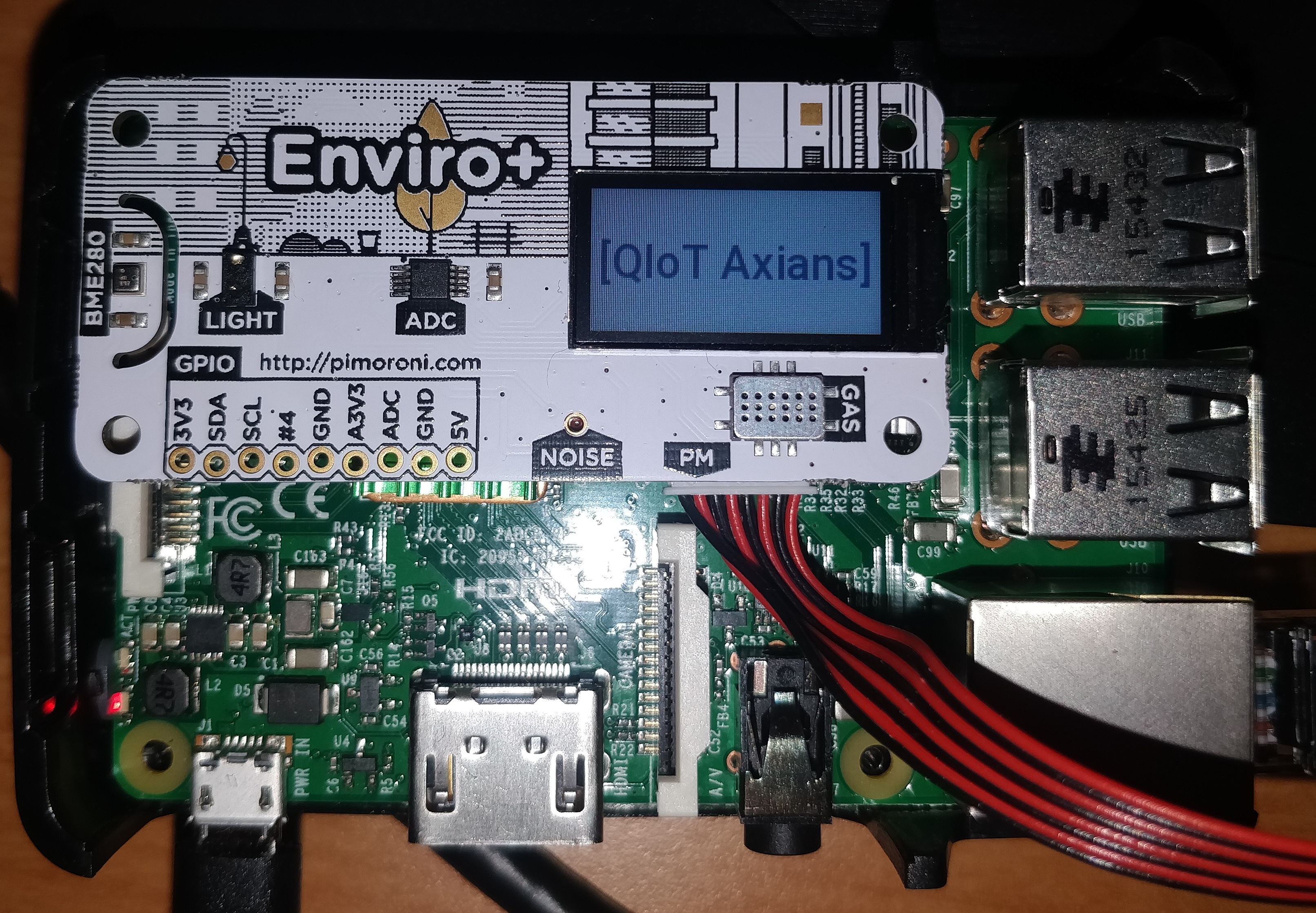QIoT Sensor
Implementation
The coding side  (not the dark side ;)
(not the dark side ;)  )
)
The python application is composed of two main part:
- The retrievers : Metrics extended class
- The API exposer : Flask application with swagger explaination
Retrievers
There are three retrievers :
- gas_extend.py
- weather_extend.py
- particules_extend.py
Example with gas_extend.py:
# gas_extend.py
from time import gmtime, strftime
from enviroplus import gas
#prom side
from prometheus_client import Gauge
from metrics import PROM_GAS_METRICS
def r_float_value_adc():
if isinstance(gas.readall().adc, float):
return gas.read_all().adc
else:
return 0
def r_float_value_nh3():
if isinstance(gas.readall().nh3, float):
PROM_GAS_METRICS['gauge']['nh3'].set(gas.read_all().nh3)
return gas.read_all().nh3
else:
return 0
def r_float_value_oxidising():
if isinstance(gas.readall().oxidising, float):
PROM_GAS_METRICS['gauge']['oxidising'].set(gas.read_all().oxidising)
return gas.read_all().oxidising
else:
return 0
def r_float_value_reducing():
if isinstance(gas.readall().reducing, float):
PROM_GAS_METRICS['gauge']['reducing'].set(gas.read_all().reducing)
return gas.read_all().reducing
else:
return 0
def json_parsing_return():
d_jsonexport={}
d_jsonexport['instant']=strftime("%Y-%m-%d %H:%M:%S%Z", gmtime())
d_jsonexport['nh3']=gas.read_all().nh3
d_jsonexport['oxidising']=gas.read_all().oxidising
d_jsonexport['reducing']=gas.read_all().reducing
PROM_GAS_METRICS['gauge']['nh3'].set(d_jsonexport['nh3'])
PROM_GAS_METRICS['gauge']['oxidising'].set(d_jsonexport['oxidising'])
PROM_GAS_METRICS['gauge']['reducing'].set(d_jsonexport['reducing'])
return d_jsonexport
Each of this have checking functions which enable to validate the type of values, and one which return the formatted values in json.
API Exposer
the main app : app.py
This application is composed of multiple route with specific actions, I describe it for you ;-) :
- /
- Method : GET
- the main route, it show a Welcome Message, and it can be use it to check the avaiability of the service
{ "result":{"Hello QIoT"}}
- /api/sensors
- Method : GET
- this path display the differents route, it is a basic / static functions
{"result":{}}
- /api/sensors/{gas,weather,pollution}
- Method : GET
-
return the value of the sensor
- /api/lcd
- Method : POST
- Display message into LCD screen
- /api/docs
- Method : GET
- Return a docs about the API (Swagger)
Also we managed the 404 error page
#!/usr/bin/env python3
# Import basic libs
import time
import os
import atexit
# Import flask for webservice and prometheus for metrics
from flask import Flask,jsonify, Response,request, render_template
from prometheus_client import generate_latest, CONTENT_TYPE_LATEST
# Import applications libs
from metrics import REQUEST_TIME
import gas_extend
import particules_extend
import weather_extend
import lcd
atexit.register(lcd.stop)
# Create Flask application
app = Flask(__name__)
@app.route('/metrics')
def metrics():
"""Flask endpoint to gather the metrics, will be called by Prometheus."""
return Response(generate_latest(), mimetype=CONTENT_TYPE_LATEST)
@app.route('/', methods=['GET'])
def index():
result={}
result['result']="Hello QIoT"
return jsonify(result)
@app.route('/api/sensors', methods=['GET'])
def listsensor():
if request.method == 'GET':
listofSensor=[]
listofSensor.append('/api/sensors/gas')
listofSensor.append('/api/sensors/pollution')
listofSensor.append('/api/sensors/weather')
listofSensor.append('/api/lcd')
result={}
result={"result":listofSensor}
return jsonify(result)
@app.route('/api/sensors/gas', methods=['GET'])
def get_data_gas():
if request.method == 'GET':
result={}
result={"result":gas_extend.json_parsing_return()}
return jsonify(result)
@app.route('/api/sensors/pollution', methods=['GET'])
def get_data_particules():
if request.method == 'GET':
result={}
result={"result":particules_extend.json_parsing_return()}
return jsonify(result)
@app.route('/api/lcd', methods=['POST'])
def post_message_to_lcd():
if request.method == 'POST':
data=request.get_json()
result={"result":{"message posted":lcd.draw_message(data['message'])}}
return jsonify(result)
@app.route('/api/sensors/weather', methods=['GET'])
@REQUEST_TIME.time()
def get_weather():
if request.method == 'GET':
result={}
result={"result":weather_extend.json_parsing_return()}
return jsonify(result)
@app.route('/api/docs')
def get_docs():
print('sending docs')
return render_template('swaggerui.html')
@app.errorhandler(404)
def ressource_not_found(e):
error="{0}".format(e)
return jsonify({"result":error}), 404
if __name__=='__main__':
lcd.draw_message()
app.run(host=os.getenv('FLASK_APP_HOST'),port=os.getenv('FLASK_APP_PORT'),
debug=os.getenv('FLASK_APP_DEBUG'))
For all of this we use Flask, we don’t use [python3 app.py] to run the app. we use gunicorn to run it in production mode.
Container image
To be compliant with the specifications, the container image is built based on the Fedora 31, with the following:
- Fedora base image, including all packages and python libraries to interract with the Raspberry Pi
- Fedora flask image, including python libraries and environment variables to launch flask application
The container is started with the following parameters:
-das detach--network=qiotto be run in a specific dedicated network-- privilegedto access to external devices such as GPIOs-p 8000:8000to expose external port 8000 (see prometheus, not used for production)--name qiot-sensorto define a tiny name
Issues, Ideas
Container Alpine
The current container is 970 MB, which is HUGE for a simple flask application. This is due mainly to:
- Fedora base image
- Python libraries and dependencies
- Unoptimised docker image build
We tried to build an alpine linux container, but the numpy python package is still compiling on aarch64 device…
LCD
The Enviro+ board includes a LCD screen. We could use it to display usefull local information, inspired from pimoroni examples.
Instead, we prefer displaying useless information, and provides API endpoint, so if you want to post some text, on the board, you can:
curl -X POST -H 'Content-Type: application/json' -i 'http://127.0.0.1:8000/api/lcd' --data '{
"message": "Axians loves QIoT"
}'
Below the startup message:

Annexes
Build process
- Checkout code
- Build image
- Login to Quay.io
- Push to Quay!
$ git clone https://github.com/ACB-FR/qiot-sensor-py
$ cd qiot-sensor-py
$ sudo podman build -t quay.io/acb-fr/qiot-sensor -t quay.io/acb-fr/qiot-sensor:1-aarch64 -t quay.io/acb-fr/qiot-sensor:1.0.3 .
$ sudo podman login
$ sudo podman push quay.io/acb-fr/qiot-sensor:1.0.3
Note: podman commands are run in sudo mode, as the container runs in privileged mode, and it’s easier for that PoC to build and run container as root.
Start Container
Once the container is built, run it!
$ sudo podman run -d --network=qiot --privileged -p 8000:8000 --name qiot-sensor quay.io/acb-fr/qiot-sensor:1.0.3
Make it restart automatically on boot with systemd:
- Generate systemd file
- Modify to comply with new linux tree
/run - Copy and activate service
$ sudo podman generate systemd --name qiot-sensor > podman-qiot-sensor.service
$ vi podman-qiot-sensor.service
PIDFile=/run/containers/storage/overlay-containers/[...]/userdata/conmon.pid
$ sudo systemctl daemon-reload
$ sudo systemctl enable podman-qiot-sensor
$ sudo systemctl start podman-qiot-sensor.service
- Check it runs!
$ sudo systemctl status podman-qiot-sensor.service
● podman-qiot-sensor.service - Podman container-qiot-sensor.service
Loaded: loaded (/etc/systemd/system/podman-qiot-sensor.service; enabled; vendor preset: disabled)
Active: active (running) since Tue 2020-09-22 19:24:41 UTC; 5min ago
Docs: man:podman-generate-systemd(1)
Main PID: 97930 (conmon)
Tasks: 3 (limit: 997)
Memory: 3.4M
CPU: 1.940s
CGroup: /system.slice/podman-qiot-sensor.service
├─97928 /usr/sbin/dnsmasq -u root --conf-file=/run/containers/cni/dnsname/qiot/dnsmasq.conf
└─97930 /usr/bin/conmon --api-version 1 -s -c 8ffb54b96b1abf4b9d1144d5458a72dd20cd51c0b9b4f64134670d32d5cfad8d -u 8ffb54b96b1abf4b9d1144d5458a72dd20cd51c0b9b4f64134670d32d5cfad8d -r /usr/bin>
Sep 22 19:24:41 qiot.verchere.lab dnsmasq[97928]: using local addresses only for domain dns.podman
Sep 22 19:24:41 qiot.verchere.lab dnsmasq[97928]: reading /etc/resolv.conf
Sep 22 19:24:41 qiot.verchere.lab dnsmasq[97928]: using local addresses only for domain dns.podman
Sep 22 19:24:41 qiot.verchere.lab dnsmasq[97928]: using nameserver 192.168.1.10#53
Sep 22 19:24:41 qiot.verchere.lab dnsmasq[97928]: using nameserver 192.168.1.254#53
Sep 22 19:24:41 qiot.verchere.lab dnsmasq[97928]: read /run/containers/cni/dnsname/qiot/addnhosts - 1 addresses
Sep 22 19:24:41 qiot.verchere.lab podman[97782]: 2020-09-22 19:24:41.29127181 +0000 UTC m=+1.755286386 container init 8ffb54b96b1abf4b9d1144d5458a72dd20cd51c0b9b4f64134670d32d5cfad8d (image=quay.io/acb>
Sep 22 19:24:41 qiot.verchere.lab podman[97782]: 2020-09-22 19:24:41.336614494 +0000 UTC m=+1.800629071 container start 8ffb54b96b1abf4b9d1144d5458a72dd20cd51c0b9b4f64134670d32d5cfad8d (image=quay.io/a>
Sep 22 19:24:41 qiot.verchere.lab podman[97782]: qiot-sensor
Sep 22 19:24:41 qiot.verchere.lab systemd[1]: Started Podman container-qiot-sensor.service.
